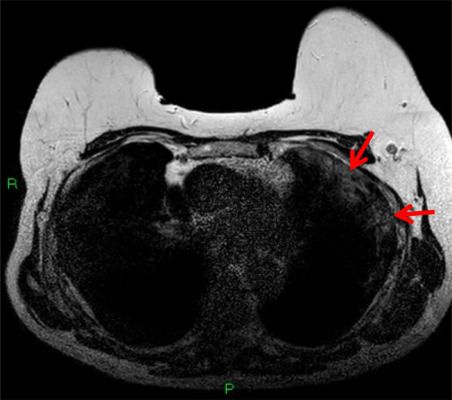Breast MRI Spots Asymptomatic COVID-19 Infection
A follow-up breast screening MRI ended with a woman from England being treated for viral infection.
A breast screening MRI led a woman to be treated for COVID-19 infection.
According to case published in the September print issue of Radiology Case Reports, abnormal lung findings detected by a radiologist sent the 68-year-old woman from England to be evaluated for viral infection.
“Given the predilection of COVID-19 for affecting the respiratory system, any imaging which encompasses all or part of the lungs could display incidental changes of the infection,” said the team led by Anmol Malhotra, a consulting radiologist and breast imaging lead with Royal Free Hospital in London.
According to the case report, the woman was initially referred to Royal Free Hospital for local staging after she received a diagnosis of invasive lobular breast carcinoma when a unifocal carcinoma in the upper, outer quadrant of her left breast was picked up on mammography. At the time she presented for her screening MRI, she was asymptomatic for the virus.
T2W TSE MR axial image showing incidental sub-pleural high T2 signal (red arrows). Courtesy: Radiology Case Reports

However, the radiologist interpreting her scan also noticed abnormal findings in her lung, as well. Specifically, her provider detected abnormal subpleural high T2 signal intensity in lung periphery. Post-contrast, fat-saturated T1-weighted images also caught enhancement in subpleural regions.
The patient was immediately contacted given concerns about the high prevalence rate of the virus on her geographic area at the time, and she was encouraged to seek follow-up care. A subsequent X-ray revealed peripheral patchy airspace consolidation, and she was instructed to self-isolate.
“This represents the first case of COVID-19 identified on breast MR imaging that [we] have seen and highlights the importance of prompt identification and flagging of incidental pulmonary findings to minimize further transmission of the virus in asymptomatic carriers,” the authors wrote.
Although she had been asymptomatic, she developed shortness-of-breath within a day of the X-ray and sought care in the emergency department. At that time, a CT scan showed bilateral subpleural ground-glass opacities with consolidation. In addition, the COVID-19 diagnosis was further bolstered because the image showed multiple right lower-lobe segmental acute pulmonary emboli. During treatment for the virus, the patient did develop an incidental pulmonary embolism secondary to the COVID-19 infection from which she recovered. Ultimately, she was discharged from the hospital.
PA erect chest radiograph demonstrating bilateral ill-defined air space opacification. Courtesy: Radiology Case Reports

Throughout the pandemic, there has been less published about the use of MRI in detecting findings that might indicate COVID-19 infection. But, the authors said, this case highlights the need for providers to examine images that even partially include the lungs, looking for potential evidence of possible infection. They pointed to not only breast MRI, but shoulder trauma imaging, as well as some abdominal CT and MRI scans.
“Identification of these findings in asymptomatic patients allows appropriate isolation measures of patient and household contacts to be commenced to minimize further spread of the virus and also allows safety net advice to be given to make the patient aware of any possible future deterioration,” the authors said. “Training of radiographers to identify suspicious lung changes at the time of image acquisition can allow for appropriate cleaning of equipment and surroundings to minimize risk of infection to subsequent patients.”
Can Abbreviated MRI Have an Impact in Rectal Cancer Staging?
April 4th 2025Abbreviated MRI demonstrated a 95.3 percent specificity for rectal cancer and provided strong agreement with the full MRI protocol for T staging and detection of extramural venous invasion, according to newly published research.
Can Photon-Counting CT be an Alternative to MRI for Assessing Liver Fat Fraction?
March 21st 2025Photon-counting CT fat fraction evaluation offered a maximum sensitivity of 81 percent for detecting steatosis and had a 91 percent ICC agreement with MRI proton density fat fraction assessment, according to new prospective research.